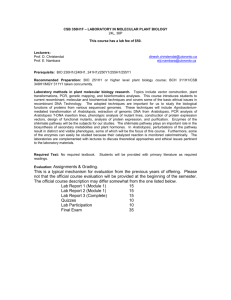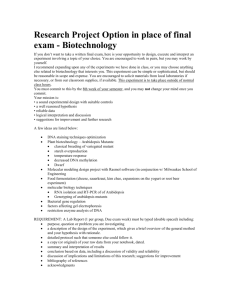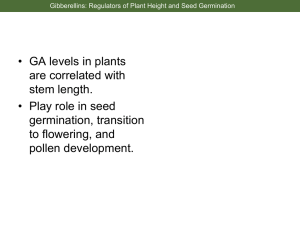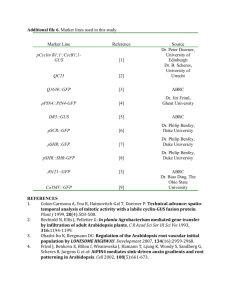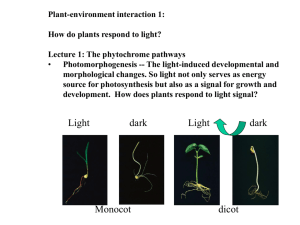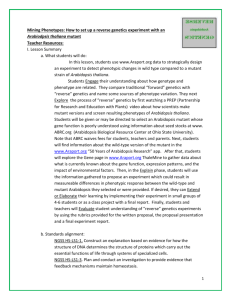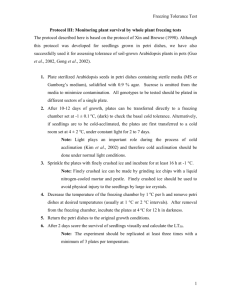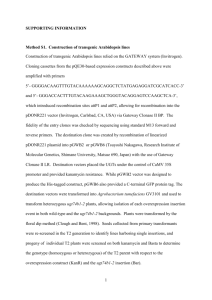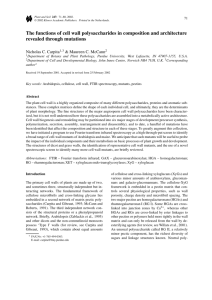Lab Protocol for “Who turned out the lights?” How plants sense and
advertisement
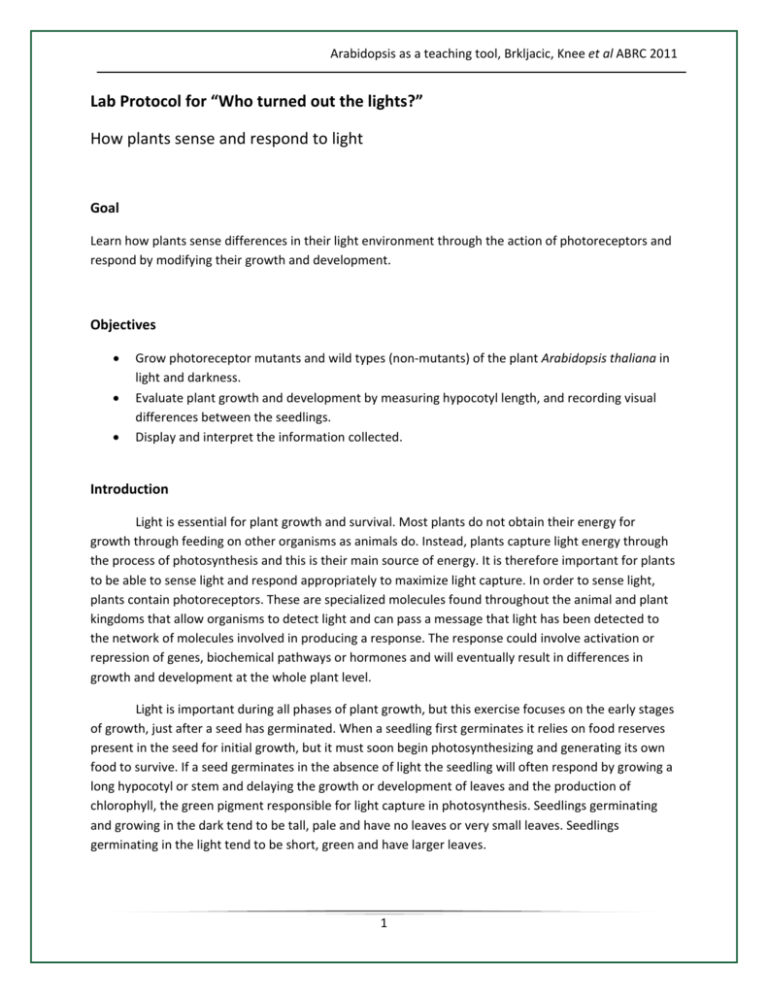
Arabidopsis as a teaching tool, Brkljacic, Knee et al ABRC 2011 Lab Protocol for “Who turned out the lights?” How plants sense and respond to light Goal Learn how plants sense differences in their light environment through the action of photoreceptors and respond by modifying their growth and development. Objectives • • • Grow photoreceptor mutants and wild types (non‐mutants) of the plant Arabidopsis thaliana in light and darkness. Evaluate plant growth and development by measuring hypocotyl length, and recording visual differences between the seedlings. Display and interpret the information collected. Introduction Light is essential for plant growth and survival. Most plants do not obtain their energy for growth through feeding on other organisms as animals do. Instead, plants capture light energy through the process of photosynthesis and this is their main source of energy. It is therefore important for plants to be able to sense light and respond appropriately to maximize light capture. In order to sense light, plants contain photoreceptors. These are specialized molecules found throughout the animal and plant kingdoms that allow organisms to detect light and can pass a message that light has been detected to the network of molecules involved in producing a response. The response could involve activation or repression of genes, biochemical pathways or hormones and will eventually result in differences in growth and development at the whole plant level. Light is important during all phases of plant growth, but this exercise focuses on the early stages of growth, just after a seed has germinated. When a seedling first germinates it relies on food reserves present in the seed for initial growth, but it must soon begin photosynthesizing and generating its own food to survive. If a seed germinates in the absence of light the seedling will often respond by growing a long hypocotyl or stem and delaying the growth or development of leaves and the production of chlorophyll, the green pigment responsible for light capture in photosynthesis. Seedlings germinating and growing in the dark tend to be tall, pale and have no leaves or very small leaves. Seedlings germinating in the light tend to be short, green and have larger leaves. 1 Arabidopsis as a teaching tool, Brkljacic, Knee et al ABRC 2011 Scientists study plant responses to environmental stimuli such as light to learn about the factors controlling plant growth in general and to study in detail the molecules involved in sensing the signal and in producing the response. Insight gained from studying these types of molecules in plants can be translated to work on animals or even humans. The model plant Arabidopsis thaliana (Arabidopsis) is well suited to this type of investigation. Many mutants of Arabidopsis are available allowing scientists to investigate the networks of genes and proteins involved in sensing and responding to light. Phytochromes are a major class of photoreceptors in plants and a range of phytochrome mutants of Arabidopsis are available. They mostly differ by the quality of light they sense and respond to. In the mutants, specific phytochrome photoreceptors are absent, or non‐functional, and the plant might be expected not to be able to sense certain quality of light. 2 Arabidopsis as a teaching tool, Brkljacic, Knee et al ABRC 2011 About the Plants CS20 (Ler) the wild type (non‐mutant) plant CS6213 (phyB‐5) an ethylmethane sulfonate induced mutant in the phytochrome B gene. Phytochrome B is a photoreceptor involved in sensing red light CS6219 (phyA‐201) an ethylmethane sulfonate induced mutant in the phytochrome A gene. Phytochrome A is a photoreceptor involved in sensing far‐red light CS6224 (phyB‐5, phyA‐210) a double mutant created by crossing phyB‐5 and phyA‐201. Both photoreceptors are mutated in the same plant 3 Arabidopsis as a teaching tool, Brkljacic, Knee et al ABRC 2011 Timeline Day 1 plant Day 4 expose to light or dark Day 8 observe and measure 4 Arabidopsis as a teaching tool, Brkljacic, Knee et al ABRC 2011 Materials Arabidopsis seeds Murashige and Skoog (MS) agar medium in petri dishes Wax paper Toothpicks Marker Surgical paper tape Aluminum foil Fluorescent lights Refrigerator Ruler Magnifying glass 5 Arabidopsis as a teaching tool, Brkljacic, Knee et al ABRC 2011 Experimental Protocols Planting seed • Sprinkle seeds from a tube onto a small piece of wax paper. Use a different piece of wax paper for each genotype of seed. • Place 15 seeds on the surface of the agar medium in a petri dish using a toothpick. Touch the toothpick to the surface of the plate to wet it, and then touch a seed to pick it up. Touch the surface of the agar again to place the seed on the media. Seal the dish with surgical tape and wrap it in aluminum foil. • Each student or group of students should prepare two petri dishes for each seed type (wild type, phyA, phyB and phyA/B double mutants), a total of eight plates. Plant growth • • • • Petri dishes should be placed in the refrigerator (4°C) for 3 days in order to promote uniform germination. This process is called stratification. Remove the dishes from the refrigerator, remove the foil from one petri dish for each seed type and place it under fluorescent lights. Do not remove the foil from the second petri dish for each seed type. These petri dishes should be placed in a drawer or closet in the same room as the petri dishes under the lights. Allow plants to grow for 4 days. 6 Arabidopsis as a teaching tool, Brkljacic, Knee et al ABRC 2011 Assignment 1 (Day 1) Experimental design and Prediction • • List the controls and variables for this experiment Predict how the treatment (light or dark) will affect the wild‐type and mutant plants Assignment 2 (Day 8) Observations and measurements • • Observe plant growth and make notes of your observations in your notebook. Use a magnifying glass or a dissecting microscope if necessary. Make note of the color of the hypocotyls and cotyledons, the shape and size of the seedling and pay attention to the differences between controls and treatments as well as between wild type and mutants. Draw diagrams to illustrate the differences you see. Record the length of the hypocotyls in mm. Measure with a ruler. Assignment 3 Data display and Interpretation • • • Decide how to display the hypocotyl length data you collected and create the display. Use the data to determine how light or the absence of light affected the different plants. Compare your interpretations to the predictions you made in Assignment 1. Use what you have learned to draw your own conclusions about the importance of phytochrome photoreceptors in plants, particularly phytochromes A and B. Assignment 4 Extensions, further reading may be required to answer these questions: • • • Why do plants grow tall and skinny in the dark? Why are plants white in the dark? Why are there several photoreceptors in plants and not just one? 7


